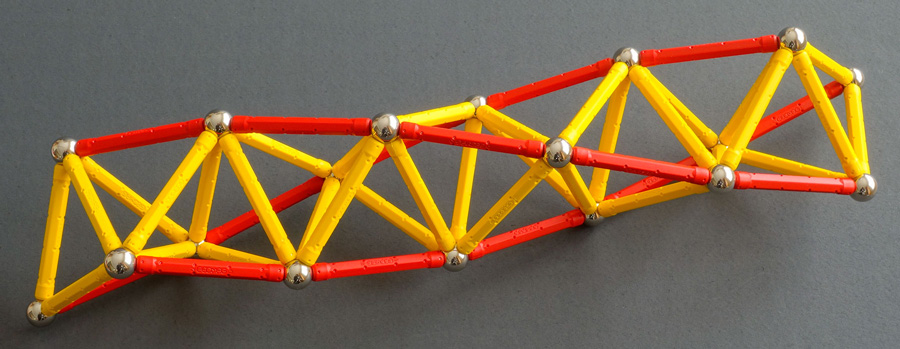A tetrahedral snake, sometimes called a Steinhaus snake, is a collection of tetrahedra, linked face to face.

Steinhaus showed in 1956 that the last tetrahedron in the snake can never be a translation of the first one. This is a consequence of the fact that the group generated by the four reflexions in the faces of a tetrahedron form the free product $C_2 \ast C_2 \ast C_2 \ast C_2$.
For a proof of this, see Stan Wagon’s book The Banach-Tarski paradox, starting at page 68.
The tetrahedral snake we will look at here is a snake in the Big Picture which we need to determine the moonshine group $(3|3)$ corresponding to conjugacy class 3C of the Monster.
The thread $(3|3)$ is the spine of the $(9|1)$-snake which involves the following lattices
\[
\xymatrix{& & 1 \frac{1}{3} \ar@[red]@{-}[dd] & & \\
& & & & \\
1 \ar@[red]@{-}[rr] & & 3 \ar@[red]@{-}[rr] \ar@[red]@{-}[dd] & & 1 \frac{2}{3} \\
& & & & \\
& & 9 & &} \]
It is best to look at the four extremal lattices as the vertices of a tetrahedron with the lattice $3$ corresponding to its point of gravity.
The congruence subgroup $\Gamma_0(9)$ fixes each of these lattices, and the arithmetic group $\Gamma_0(3|3)$ is the conjugate of $\Gamma_0(1)$
\[
\Gamma_0(3|3) = \{ \begin{bmatrix} \frac{1}{3} & 0 \\ 0 & 1 \end{bmatrix}.\begin{bmatrix} a & b \\ c & d \end{bmatrix}.\begin{bmatrix} 3 & 0 \\ 0 & 1 \end{bmatrix} = \begin{bmatrix} a & \frac{b}{3} \\ 3c & 1 \end{bmatrix}~|~ad-bc=1 \} \]
We know that $\Gamma_0(3|3)$ normalizes the subgroup $\Gamma_0(9)$ and we need to find the moonshine group $(3|3)$ which should have index $3$ in $\Gamma_0(3|3)$ and contain $\Gamma_0(9)$.
So, it is natural to consider the finite group $A=\Gamma_0(3|3)/\Gamma_9(0)$ which is generated by the co-sets of
\[
x = \begin{bmatrix} 1 & \frac{1}{3} \\ 0 & 1 \end{bmatrix} \qquad \text{and} \qquad y = \begin{bmatrix} 1 & 0 \\ 3 & 0 \end{bmatrix} \]
To determine this group we look at the action of it on the lattices in the $(9|1)$-snake. It will fix the central lattice $3$ but will move the other lattices.
Recall that it is best to associate to the lattice $M.\frac{g}{h}$ the matrix
\[
\alpha_{M,\frac{g}{h}} = \begin{bmatrix} M & \frac{g}{h} \\ 0 & 1 \end{bmatrix} \]
and then the action is given by right-multiplication.
\[
\begin{bmatrix} 1 & 0 \\ 0 & 1 \end{bmatrix}.x = \begin{bmatrix} 1 & \frac{1}{3} \\ 0 & 1 \end{bmatrix}, \quad \begin{bmatrix} 1 & \frac{1}{3} \\ 0 & 1 \end{bmatrix}.x = \begin{bmatrix} 1 & \frac{2}{3} \\ 0 & 1 \end{bmatrix}, \quad \begin{bmatrix} 1 & \frac{2}{3} \\ 0 & 1 \end{bmatrix}.x=\begin{bmatrix} 1 & 0 \\ 0 & 1 \end{bmatrix} \]
That is, $x$ corresponds to a $3$-cycle $1 \rightarrow 1 \frac{1}{3} \rightarrow 1 \frac{2}{3} \rightarrow 1$ and fixes the lattice $9$ (so is rotation around the axis through the vertex $9$).
To compute the action of $y$ it is best to use an alternative description of the lattice, replacing the roles of the base-vectors $\vec{e}_1$ and $\vec{e}_2$. These latices are projectively equivalent
\[
\mathbb{Z} (M \vec{e}_1 + \frac{g}{h} \vec{e}_2) \oplus \mathbb{Z} \vec{e}_2 \quad \text{and} \quad \mathbb{Z} \vec{e}_1 \oplus \mathbb{Z} (\frac{g’}{h} \vec{e}_1 + \frac{1}{h^2M} \vec{e}_2) \]
where $g.g’ \equiv~1~(mod~h)$. So, we have equivalent descriptions of the lattices
\[
M,\frac{g}{h} = (\frac{g’}{h},\frac{1}{h^2M}) \quad \text{and} \quad M,0 = (0,\frac{1}{M}) \]
and we associate to the lattice in the second normal form the matrix
\[
\beta_{M,\frac{g}{h}} = \begin{bmatrix} 1 & 0 \\ \frac{g’}{h} & \frac{1}{h^2M} \end{bmatrix} \]
and then the action is again given by right-multiplication.
In the tetrahedral example we have
\[
1 = (0,\frac{1}{3}), \quad 1\frac{1}{3}=(\frac{1}{3},\frac{1}{9}), \quad 1\frac {2}{3}=(\frac{2}{3},\frac{1}{9}), \quad 9 = (0,\frac{1}{9}) \]
and
\[
\begin{bmatrix} 1 & 0 \\ \frac{1}{3} & \frac{1}{9} \end{bmatrix}.y = \begin{bmatrix} 1 & 0 \\ \frac{2}{3} & \frac{1}{9} \end{bmatrix},\quad
\begin{bmatrix} 1 & 0 \\ \frac{2}{3} & \frac{1}{9} \end{bmatrix}. y = \begin{bmatrix} 1 & 0 \\ 0 & \frac{1}{9} \end{bmatrix}, \quad
\begin{bmatrix} 1 & 0 \\ 0 & \frac{1}{9} \end{bmatrix}. y = \begin{bmatrix} 1 & 0 \\ \frac{1}{3} & \frac{1}{9} \end{bmatrix} \]
That is, $y$ corresponds to the $3$-cycle $9 \rightarrow 1 \frac{1}{3} \rightarrow 1 \frac{2}{3} \rightarrow 9$ and fixes the lattice $1$ so is a rotation around the axis through $1$.
Clearly, these two rotations generate the full rotation-symmetry group of the tetrahedron
\[
\Gamma_0(3|3)/\Gamma_0(9) \simeq A_4 \]
which has a unique subgroup of index $3$ generated by the reflexions (rotations with angle $180^o$ around axis through midpoints of edges), generated by $x.y$ and $y.x$.
The moonshine group $(3|3)$ is therefore the subgroup generated by
\[
(3|3) = \langle \Gamma_0(9),\begin{bmatrix} 2 & \frac{1}{3} \\ 3 & 1 \end{bmatrix},\begin{bmatrix} 1 & \frac{1}{3} \\ 3 & 2 \end{bmatrix} \rangle \]
Comments